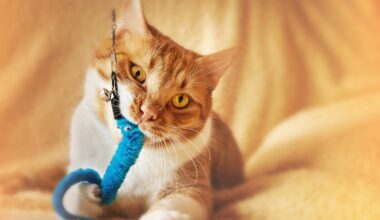Identifying Anxiety-Driven Jumping in Cats
Jumping is a natural behavior for cats, but when it becomes excessive, it can be a signal of underlying problems. Many cats exhibit climbing and jumping behaviors due to anxiety. When a cat jumps frequently without visible reason, it may be an attempt to escape stress or express frustration. Identifying signs of anxiety is essential to improve their well-being. Owners should look for additional symptoms like vocalization, hiding, or aggressive behaviors. Recognizing these signs requires keen observation. For instance, some cats may jump onto high surfaces to gain a sense of security. Histories of trauma or environmental changes can exacerbate anxiety-driven behaviors. Providing a vertical space can help, possibly reducing some anxiety. Additionally, enriching their environment with toys and scratching posts will help alleviate stress. Make sure to observe your cat’s interactions with its surroundings closely. If you notice a pattern of jumping linked to specific stimuli, it’s essential to note these triggers. Identifying anxiety-related issues might involve trial and error but can lead to a happier, more balanced feline friend.
Another helpful approach is to ensure that your cat’s routine remains stable and predictable. Cats thrive on routine, and disruptions in their daily lives can introduce unnecessary stress. When changes happen, such as moving, new pets, or even changes in your schedule, they may react by jumping or exhibiting other anxiety-driven behaviors. Gradually introducing new environments or situations can significantly reduce anxiety levels. Consider employing calming aids such as pheromone diffusers or anxiety wraps. Many feline-friendly products are available that can help soothe nerves. It’s vital to give your cat time to adjust to any new changes, offering consistent love and support. Interactive play sessions can allow relief from anxiety and provide physical exercise. Monitor your cat’s body language during and after these activities closely. If your cat shows signs of discomfort, you may need to alter your methods. Keeping a close eye for when jumping seems anxiety-driven can help establish a correlation. Addressing these issues early will help prevent the behaviors from escalating and may encourage a healthier relationship with your cat.
Environment and Triggers
Understanding your cat’s environment is crucial in identifying anxiety-driven jumping behaviors. Examine their surroundings for any sensory triggers like loud noises, unfamiliar scents, or sudden movements. These factors may lead to overactive reactions, causing your cat to jump more frequently. Cats use height as a form of safety, so a chaotic environment might drive them to seek elevated spots. Also, consider how changes in household dynamics affect your pet. New animals or even guests can heighten anxiety levels, provoking jumping fits. It’s helpful to limit access to areas where stressors exist. Providing safe zones, quiet spaces, and resources can create an atmosphere where your cat feels secure. Establishing an invitation-only access to certain rooms may greatly reduce anxiety. Monitor your cat’s behavior around other pets or people to better understand their triggers. Knowing which situations provoke stress leads to sustainable behavior adjustments. If necessary, consult professionals for behavioral evaluations. By modifying your cat’s environment in manageable ways, you can empower them to feel safe, lowering the urgency of anxiety-driven jumps.
Physical health must also be assessed when dealing with anxiety-related jumping. Certain medical conditions can lead to changes in behavior and may mimic anxiety-driven actions. It’s a good practice to schedule regular veterinary check-ups to rule out any underlying issues. Conditions like hyperthyroidism or arthritis can create discomfort, triggering erratic jumping or climbing. Observing your pet’s patterns and reactions can provide insights into their overall health. Behavioral changes might correlate with physical ailments, which influences how you manage the situation. Regular health screenings can be a proactive approach in addressing both jumping and health dilemmas. If your cat is in pain, they might jump out of instinctive reaction or from distress. Adequate pain management is crucial for calming excessive activity. Providing your feline friend with proper nutrition also supports emotional well-being. Maintaining a balanced diet enhances their immune system and helps manage stress. Investing time and resources into both health and behavior will ensure a holistic approach to your cat’s anxiety-driven activities.
Building Confidence Through Training
Training is an effective strategy to address anxiety-related jumping in cats. Positive reinforcement techniques are expressed through rewards for desired behaviors, helping build trust and confidence. Start slowly introducing your cat to various commands and tricks. The incorporation of training sessions can help redirect their focus, building mental stimulation that decreases anxiety levels. Use treats, toys, or affection as rewards when they exhibit calm behavior instead of jumping. Consistency is key in reinforcing good behavior over time. Creating a structured learning environment will ensure your cat feels secure and engaged. Start with short, positive sessions to prevent overwhelming them. Gradually introduce more complex tasks to keep them interested, keeping motivation high. Working together on specific objectives fosters a bond and encourages a sense of accomplishment. Also, including play in their training routine can organically reduce anxiety-driven jumping. Training and playtime combined allows your cat to express natural instincts while providing a safe space to explore. Additionally, being patient during training is crucial; progress may come slowly but will lead to long-term improvements.
When managing anxiety-driven jumping, collaboration with professionals can be beneficial. Consulting cat behaviorists or trainers specializing in anxiety issues brings valuable experience to the table. They can observe your cat’s actions in a non-judgmental, informed manner, offering personalized guidance suited to your specific circumstances. Behaviorists provide strategies tailored to your home and lifestyle. This may involve adjusting current training methods or reevaluating environmental factors. Open communication allows for discussing potential medication options should behavioral modifications prove insufficient. Various anxiety medications exist to assist your pet in coping. Understanding when to seek professional help reduces the risk of the behaviors becoming ingrained. It may take time to achieve your goals, requiring adjustments in methods based on your cat’s responses. A well-rounded approach, combining professional advice with owner diligence, often yields the best results. Empowering your cat through knowledge, attention, and available resources makes it possible to navigate anxiety-related challenges. Emotional support creates a cohesive team dedicated to your cat’s happiness.
Conclusion and Insights
Overall, identifying anxiety-driven jumping in cats is essential for maintaining their health and well-being. Paying attention to patterns, triggers, and environmental factors ensures a more in-depth understanding of their behavior. Committed pet owners can create nurturing spaces that promote relaxation and tranquility. Training and positive reinforcement play pivotal roles in redirecting anxiety-driven habits towards healthier outlets. Physical health should also not be overlooked, as it can contribute to such behaviors. Implementing holistic strategies including professional guidance can produce long-lasting changes, benefiting both cats and their families. Focus on building confidence, adapting environments, and monitoring health make significant impacts. By taking proactive steps and remaining observant, owners can foster an environment conducive to comfort, reducing anxiety-driven jumping through empowerment and understanding.
Ultimately, the journey to understanding your cat’s anxiety-driven jumping behaviors can be enlightening. Realizing the importance of stability, enrichment, and health can create bonds that result in happier, more secure cats. By prioritizing their emotional needs while addressing possible physical health issues, you embark on a path leading to improved behavior. Seeking avenues of engagement, like interactive play and training, further nurtures confidence. The continuous interaction between owner and cat translates into trust, leading to calmer and more fulfilled lives. Your determination to comprehend these behaviors will not only provide comfort but ensure a loving, nurturing home for your feline companion. With commitment and knowledge, the right approach can significantly alleviate anxiety, fostering a peaceful existence. Remember, in every jump, there may be a story waiting to be understood.


